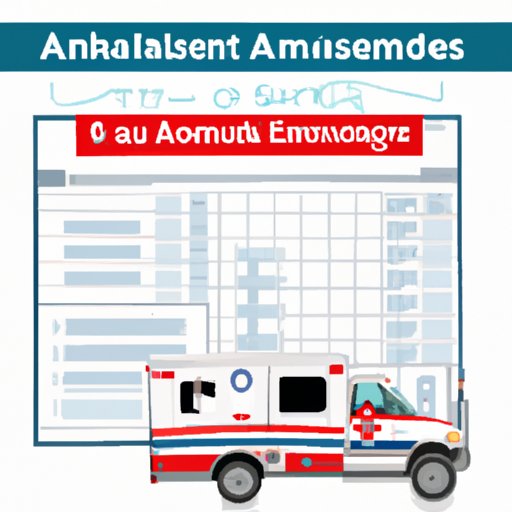Introduction
When faced with a medical emergency, calling an ambulance can be a life-saving decision. However, it can also result in a hefty bill that catches many Texans off guard. In this article, we’ll explore the cost of ambulance services in Texas, including the breakdown of expenses, insurance coverage, and payment options. We’ll also provide tips for navigating the financial impact of emergency care and understanding ambulance bills.
The Cost of Emergency Care: A Breakdown of Ambulance Costs in Texas
The cost of an ambulance ride can vary depending on a variety of factors, including the type and severity of the emergency, the distance travelled, and the type of ambulance used. In Texas, ambulance services typically have fixed costs, variable costs, and hidden fees.
Fixed Costs
Fixed costs include expenses that are charged regardless of the type of emergency or care provided. This can include the base rate charged for ambulance services, staffing costs, and overhead expenses. According to the Texas Department of State Health Services, the base rate for an emergency ambulance transport ranges from $500 to $2000, depending on the distance travelled and level of care required.
Variable Costs
Variable costs are expenses that are charged based on the type of emergency and care provided. This can include charges for medications, equipment, and procedures. For example, the use of an EKG machine or administration of IV fluids may result in additional charges on the ambulance bill.
Hidden Fees
In some cases, ambulance companies may add hidden fees to the bill that are not readily apparent. These can include charges for mileage, oxygen use, and cleaning fees. It’s important for Texans to carefully review their ambulance bills to identify any unexpected charges.
What Texans Need to Know About the Price of an Ambulance Ride
It’s important for Texans to understand their options for paying for ambulance services, as well as any insurance coverage that may be available.
Insurance Coverage for Ambulance Services
Many health insurance plans provide coverage for ambulance services, but it’s important to understand the specific terms and limitations of the policy. Some policies may only cover emergency ambulance transport, while others may also cover non-emergency services. Medicare and Medicaid also provide coverage for ambulance services for eligible individuals.
Non-Emergency Ambulance Services
In some cases, Texans may need to use ambulance services for non-emergency transport, such as transferring a patient between hospitals or medical facilities. Non-emergency services may be covered by insurance plans, but with different terms and limitations than emergency services.
Payment Options
For Texans without insurance coverage for ambulance services, there are still options for paying for emergency care. Many ambulance companies offer payment plans or may be willing to negotiate the bill. Texans may also be able to apply for financial assistance or charity care programs offered by hospitals and medical facilities.
The Financial Impact of Calling an Ambulance in Texas
The high cost of ambulance services can have a significant impact on individuals’ finances and health insurance policies.
High Cost of Ambulance Services
The cost of an ambulance ride can easily add up to thousands of dollars, which can be a hardship for many Texans, especially those with low incomes or limited insurance coverage.
Impact on Individuals’ Finances
Ambulance bills can also have a negative impact on individuals’ finances, potentially leading to debt or bankruptcy. It’s important for Texans to carefully review their bills and explore payment options to avoid negative financial consequences.
Effect on Health Insurance Policies
Frequent use of ambulance services can also have an effect on health insurance policies. Insurance providers may raise rates or exclude coverage for certain individuals who frequently use emergency services.

Navigating Ambulance Expenses: Tips for Texans
There are steps that Texans can take to navigate the financial impact of ambulance services and potentially lower their costs.
Knowing the Type of Insurance Coverage
If you have insurance coverage for ambulance services, make sure you understand the specific terms and limitations of the policy. This can help you avoid unexpected charges and identify ways to lower your costs.
Requesting an Itemized Bill
It’s important to carefully review your ambulance bill and request an itemized bill if necessary. This can help you identify any unexpected charges or hidden fees and potentially negotiate a lower bill.
Negotiating Payment Terms
If you’re unable to pay the full amount of your ambulance bill, you may be able to negotiate a payment plan or reduced payment with the ambulance company. It’s important to explore all your options and communicate with the company as soon as possible to avoid negative consequences.
Why the Cost of Ambulance Services in Texas Varies and How to Prepare
There are several factors that can affect the cost of ambulance services in Texas, and preparing ahead of time can help Texans avoid unexpected costs.
Factors That Affect Ambulance Costs
The type and severity of the emergency, the distance travelled, and the type of ambulance used can all affect the cost of ambulance services. Texans should be aware of these factors and explore their options for using different types of emergency transport, such as medical helicopters or air ambulances.
Planning Ahead for Possible Emergencies
Texans can also prepare ahead of time for possible emergencies by having a plan in place, understanding their insurance coverage, and identifying the nearest medical facilities and emergency transport options.
Knowing Where to Get Affordable Ambulance Services
For Texans without insurance coverage or with limited financial resources, it’s important to know where to get affordable ambulance services. Some ambulance companies may offer sliding-scale fees or discounts, and there may be non-profit organizations or community resources available to help.
The True Cost of Emergency Transport: Understanding Ambulance Bills in Texas
Understanding ambulance bills in Texas can help Texans avoid unexpected charges and get the care they need at an affordable cost.
Common Charges on Ambulance Bills
Common charges on ambulance bills include the base rate, mileage charges, and charges for equipment and procedures. Texans should carefully review their bills to identify any unexpected charges or hidden fees.
Understanding Medicare Coverage
Medicare provides coverage for ambulance services for eligible individuals, but with specific limitations and criteria. Texans should understand the specific terms of Medicare coverage for ambulance services and explore their options for supplemental insurance coverage.
Unforeseen Charges and How to Avoid Them
In some cases, ambulance companies may charge unexpected fees that are not covered by insurance or apparent on the initial bill. Texans can avoid these charges by carefully reviewing their bills, communicating with the ambulance company, and exploring payment options.
To Call or Not to Call: Weighing the Financial Consequences of an Ambulance Ride in Texas
Ultimately, the decision to call an ambulance should be based on the severity of the emergency and the potential health risks. However, it’s important for Texans to also consider the financial consequences of an ambulance ride.
Determining When to Call an Ambulance
If you’re not sure whether to call an ambulance, consider the severity of the emergency and whether you or the patient are stable enough to be transported by other means.
Cost-Benefit Analysis of Calling an Ambulance
It’s also important to weigh the potential health risks and benefits of calling an ambulance against the financial costs. In some cases, the cost of an ambulance ride may be worth the potentially life-saving care.
Alternative Options for Emergency Transport
There are alternative options for emergency transport, such as private ambulance services or medical helicopters, that may be more affordable or better suited to the specific emergency. It’s important to understand these options and explore the potential costs and benefits.
Conclusion
Calling an ambulance in Texas can be costly, but it’s often a necessary decision for life-saving emergency care. By understanding the cost breakdown, insurance coverage, and payment options, Texans can make informed decisions about emergency transport and navigate the financial impact of ambulance services.
Summary of Key Takeaways
Ambulance services in Texas have fixed costs, variable costs, and hidden fees, which can add up to thousands of dollars. Texans should understand their insurance coverage and explore payment options to minimize the financial impact of calling an ambulance. Preparation and understanding of ambulance bills can also help avoid unexpected charges.
Final Thoughts
Emergency care is important, but it shouldn’t come at the cost of financial hardship or debt. By taking the steps outlined in this article, Texans can get the care they need at an affordable cost and avoid negative financial consequences.
Encouragement to Take Action
If you’re facing high ambulance bills or are concerned about the potential cost of emergency care, take action today. Review your insurance coverage, explore payment options, and reach out to community resources for help. Your health and financial wellbeing depend on it.
(Note: Is this article not meeting your expectations? Do you have knowledge or insights to share? Unlock new opportunities and expand your reach by joining our authors team. Click Registration to join us and share your expertise with our readers.)
